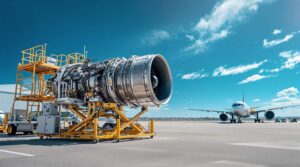In the dynamic realm of aviation, the convergence of aircraft system health management (ASHM) and physics-based modeling stands as a pivotal cornerstone. This synergy not only enhances the overall operational efficiency of aircraft but also plays a crucial role in advancing safety protocols and maintenance practices. Let’s delve into the intricacies of these interconnected domains to unravel the significance they bring to the aviation landscape.
The Essence of Aircraft System Health Management (ASHM)
Aircraft System Health Management, often abbreviated as ASHM, is a holistic approach aimed at monitoring, assessing, and managing the health and performance of various systems within an aircraft. This proactive methodology involves the integration of advanced sensors, data analytics, and artificial intelligence to provide real-time insights into the condition of critical components such as engines, avionics, and structural elements.
The primary goal of ASHM is to preemptively identify potential issues, allowing for timely maintenance interventions, thereby minimizing downtime and enhancing overall operational safety. This real-time monitoring capability significantly contributes to the longevity of aircraft and ensures optimal performance throughout their operational life cycle.
A New Frontier: Aircraft Physics-Based Modeling
Aircraft physics-based modeling complements ASHM by leveraging computational methods to simulate and analyze the physical behavior of aircraft components. This involves creating intricate mathematical models that mimic the aerodynamics, structural dynamics, and other physical attributes of an aircraft. By doing so, engineers gain invaluable insights into the expected performance under different conditions.
This modeling approach plays a pivotal role in optimizing aircraft design, evaluating performance characteristics, and even predicting potential failure modes. The synergy with ASHM is evident as physics-based modeling provides the foundation for the analytical tools used in health monitoring systems. The combination of these two methodologies forms a robust framework for predictive maintenance, ensuring that aircraft remain in optimal condition throughout their operational life.
Advancing Aviation Safety and Efficiency
The integration of ASHM and physics-based modeling represents a paradigm shift in the aviation industry. By harnessing the power of data analytics, artificial intelligence, and advanced simulation, aviation professionals can make informed decisions that enhance safety, reduce operational costs, and extend the lifespan of aircraft components.
This holistic approach also contributes to a more sustainable aviation ecosystem by minimizing unscheduled maintenance, reducing carbon footprints, and optimizing fuel efficiency. As the industry continues to evolve, the marriage of ASHM and physics-based modeling stands as a beacon of innovation, fostering a new era of smart and resilient aircraft systems.
Conclusion
In the ever-evolving landscape of aviation, the integration of Aircraft System Health Management and Aircraft Physics-Based Modeling emerges as a transformative force. This symbiotic relationship not only ensures the longevity and reliability of aircraft but also propels the industry towards greater efficiency and safety. As we navigate the skies of the future, this integrated approach will undoubtedly play a pivotal role in shaping the next generation of aviation technologies.
Fine-Tuning ASHM with Machine Learning
One of the key components enhancing Aircraft System Health Management is the incorporation of machine learning algorithms. By fine-tuning ASHM with machine learning, the system gains the capability to adapt and learn from real-time data. This dynamic approach enables more accurate predictive maintenance, as the system continuously evolves its understanding of potential issues based on historical and current performance data.
Data Fusion in ASHM
Data fusion is an integral aspect of ASHM, involving the amalgamation of information from diverse sensors and sources. This multifaceted approach enhances the accuracy and reliability of the health assessment process. By seamlessly integrating data from various components, ASHM becomes a comprehensive solution that provides a holistic view of the aircraft’s overall health.
Simulating Extreme Conditions through Physics-Based Modeling
Pushing the boundaries of Aircraft Physics-Based Modeling involves simulating extreme conditions. Engineers utilize advanced computational methods to create scenarios that replicate harsh environmental conditions, enabling a thorough understanding of how aircraft components perform under stress. This in-depth analysis aids in the development of robust designs that can withstand a variety of challenging situations.
Table: Comparative Analysis of ASHM and Physics-Based Modeling
| Aspect | ASHM | Physics-Based Modeling |
|---|---|---|
| Focus | Real-time health monitoring | Simulation and analysis of physical behavior |
| Methodology | Sensor data and AI analytics | Computational modeling and simulation |
| Application | Maintenance interventions | Optimizing design and predicting failure modes |
Frequently Asked Questions
- Q: How does ASHM contribute to aviation safety?
- Q: What role does physics-based modeling play in aircraft design?
A: ASHM enhances aviation safety by providing real-time insights into the health of critical aircraft components, allowing for proactive maintenance and minimizing the risk of in-flight failures.
A: Physics-based modeling aids in optimizing aircraft design by simulating and analyzing the physical behavior of components, enabling engineers to make informed decisions about performance and reliability.






